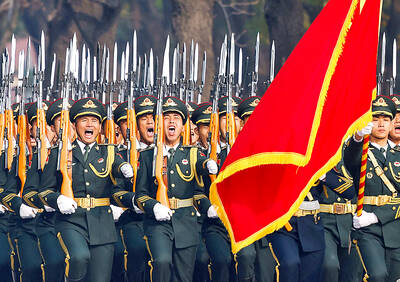Democratic Progressive Party Legislator Wu Yi-chen (吳宜臻), along with several Hakka activists, yesterday urged the Miaoli County Government to halt a project to build a tourist information center outside the planned high-speed rail station in Houlong Township (後龍), saying that its chosen architectural style has no cultural connection to Hakkas living in Miaoli.
In order to leave an impression of Hakka culture on travelers arriving at the station, the county government plans to build a tourist information center in front of the station in the tulou style (土樓) — a traditional fortress-like communal residence found in mountainous regions in the southern parts of China’s Fujian Province.
While tulou architecture is not uniquely Hakka, the architectural style is considered Hakka by many, since most remaining tulou are found in Hakka villages.

Photo courtesy of Chien Hung-wei
However, for Hakkas in Taiwan, the architectural style is as foreign as it is to many non-Hakkas.
“Chinese tulou have no cultural or historical connection to Taiwanese Hakkas, [a tulou in Miaoli] is like something that fell from the sky — it doesn’t belong to Taiwan or Miaoli,” Ceng Nian-you [曾年有], a Miaoli-based Hakka culture and history researcher, told a press conference at the Legislative Yuan in Taipei yesterday. “We have our own culture in Miaoli, why is the county government not using local cultural elements for the tourist information center?”
He said that for local Hakkas, the traditional residential building is a huofang (夥房) — literally “communal house” in Hakka — which has a square layout, with a courtyard in the middle for agricultural activities such as sun-drying rice or vegetables, or for banquets, and a hall for religious use.
“I don’t understand why the county government had to tear down century-old kilns that once stood on the site of the high-speed rail development, and replace them with something that has no local connection,” Ceng added.
Chern Ban (陳板), a visiting professor at National Taiwan University of Arts and a Hakka from Miaoli, said that there are no tulou buildings in Taiwan due to its unique society and culture, and there is no need to build one now.
“Tulou in Fujian were built for security reasons, and when Hakkas moved to Taiwan, they didn’t feel the need to build any, because, on one hand, they didn’t feel threatened, and on the other hand, the humid climate and frequent earthquakes do not suit earth buildings,” Chern said.
Ayu Huang (黃連煜), a Hakka musician from Miaoli, said that while all Hakkas may share something in common, each Hakka community has unique elements.
“Hakkas in Fujian build tulou, but most of the Hakkas in Miaoli trace their ancestry to China’s Guangdong Province, so tulou are not only unfamiliar to us, but also would have been to our ancestors,” he said. “As a musician, I would be concerned if the Miaoli County Government imported traditional Hakka music from China and called it local music.”
Wu added that if Miaoli County Commissioner Liu Cheng-hung (劉政鴻), who has come under severe criticism over his handling of controversial demolitions in Dapu Borough (大埔) last week, cares enough about Hakka culture, he should read research by the Hakka Affairs Council. This found that there are no tulou in Taiwan, and confirmed that the most representative Hakka architecture in Taiwan is the huofang.
“If he doesn’t know what a huofang looks like, he should go to Hakka villages in the county and he would easily spot some,” Wu said.

The Ministry of Foreign Affairs (MOFA) yesterday said it is closely monitoring developments in Venezuela, and would continue to cooperate with democratic allies and work together for regional and global security, stability, and prosperity. The remarks came after the US on Saturday launched a series of airstrikes in Venezuela and kidnapped Venezuelan President Nicolas Maduro, who was later flown to New York along with his wife. The pair face US charges related to drug trafficking and alleged cooperation with gangs designated as terrorist organizations. Maduro has denied the allegations. The ministry said that it is closely monitoring the political and economic situation

Conflict with Taiwan could leave China with “massive economic disruption, catastrophic military losses, significant social unrest, and devastating sanctions,” a US think tank said in a report released on Monday. The German Marshall Fund released a report titled If China Attacks Taiwan: The Consequences for China of “Minor Conflict” and “Major War” Scenarios. The report details the “massive” economic, military, social and international costs to China in the event of a minor conflict or major war with Taiwan, estimating that the Chinese People’s Liberation Army (PLA) could sustain losses of more than half of its active-duty ground forces, including 100,000 troops. Understanding Chinese

UNRELENTING: China attempted cyberattacks on Taiwan’s critical infrastructure 2.63 million times per day last year, up from 1.23 million in 2023, the NSB said China’s cyberarmy has long engaged in cyberattacks against Taiwan’s critical infrastructure, employing diverse and evolving tactics, the National Security Bureau (NSB) said yesterday, adding that cyberattacks on critical energy infrastructure last year increased 10-fold compared with the previous year. The NSB yesterday released a report titled Analysis on China’s Cyber Threats to Taiwan’s Critical Infrastructure in 2025, outlining the number of cyberattacks, major tactics and hacker groups. Taiwan’s national intelligence community identified a large number of cybersecurity incidents last year, the bureau said in a statement. China’s cyberarmy last year launched an average of 2.63 million intrusion attempts per day targeting Taiwan’s critical

‘SLICING METHOD’: In the event of a blockade, the China Coast Guard would intercept Taiwanese ships while its navy would seek to deter foreign intervention China’s military drills around Taiwan this week signaled potential strategies to cut the nation off from energy supplies and foreign military assistance, a US think tank report said. The Chinese People’s Liberation Army (PLA) conducted what it called “Justice Mission 2025” exercises from Monday to Tuesday in five maritime zones and airspace around Taiwan, calling them a warning to “Taiwanese independence” forces. In a report released on Wednesday, the Institute for the Study of War said the exercises effectively simulated blocking shipping routes to major port cities, including Kaohsiung, Keelung and Hualien. Taiwan would be highly vulnerable under such a blockade, because it